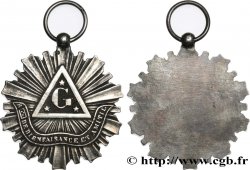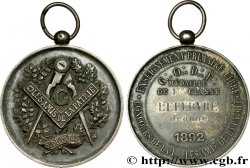fjt_01541 - FREEMASONRY LOGE ANGLAISE DE BORDEAUX 1732
Not available.
Item sold on our e-shop (2011)
Price : 58.00 €
Item sold on our e-shop (2011)
Price : 58.00 €
Type : LOGE ANGLAISE DE BORDEAUX
Date: 1732
Metal : copper
Diameter : 27 mm
Orientation dies : 12 h.
Edge : lisse
Puncheon : Abeille (1860 - 1880)
Catalogue references :
Obverse
Obverse legend : (LOGE) ANGLAISE N°204 OR.:. DE BORDEAUX À L'EXERGUE FONDEE EN 1732.
Obverse description : Un écusson à trois tours posé sur des branches d’acacia et des outils maçonniques.
Reverse
Reverse legend : SAGESSE UNION CHARITE.
Reverse description : Un niveau rayonnant.
Commentary
La franc-maçonnerie s’implante en France aux alentours du premier quart du XVIIIe s. sous l’influence d’aristocrates anglais. Initiatique, elle est fondée sur le rite hiramique, du nom d’Hiram de Tyr, personnage biblique, architecte du roi Salomon sur le chantier du Temple et qui a résisté à la torture sans livrer ses secrets. Hiram a aussi donné un point de départ du calendrier maçonnique commençant 4000 ans avant le calendrier chrétien. Les symboles servent de signes de reconnaissance entre les initiés, notamment des outils de constructeur de cathédrales (équerre, compas, niveau, maillet, etc.), des formes (triangle, étoile), des nombres (trois, cinq, sept) et des lettres.
Freemasonry was established in France around the first quarter of the 18th century under the influence of English aristocrats. An initiatory practice, it is based on the Hiramic rite, named after Hiram of Tyre, a biblical figure, architect of King Solomon on the construction site of the Temple, who withstood torture without revealing his secrets. Hiram also provided a starting point for the Masonic calendar, which began 4,000 years before the Christian calendar. Symbols serve as signs of recognition between initiates, including cathedral builder's tools (set square, compass, level, mallet, etc.), shapes (triangle, star), numbers (three, five, seven), and letters.
Freemasonry was established in France around the first quarter of the 18th century under the influence of English aristocrats. An initiatory practice, it is based on the Hiramic rite, named after Hiram of Tyre, a biblical figure, architect of King Solomon on the construction site of the Temple, who withstood torture without revealing his secrets. Hiram also provided a starting point for the Masonic calendar, which began 4,000 years before the Christian calendar. Symbols serve as signs of recognition between initiates, including cathedral builder's tools (set square, compass, level, mallet, etc.), shapes (triangle, star), numbers (three, five, seven), and letters.








 Report a mistake
Report a mistake Print the page
Print the page Share my selection
Share my selection Ask a question
Ask a question Consign / sell
Consign / sell
 Full data
Full data










